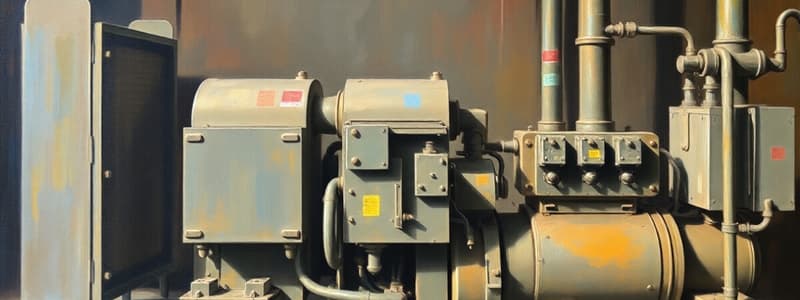Podcast
Questions and Answers
Heavy electrical systems typically operate at voltages below 1 kV.
Heavy electrical systems typically operate at voltages below 1 kV.
False (B)
Induction motors are a type of generator used in heavy electrical applications.
Induction motors are a type of generator used in heavy electrical applications.
False (B)
Transformers are essential for stepping up or stepping down voltage levels.
Transformers are essential for stepping up or stepping down voltage levels.
True (A)
The primary function of circuit breakers is to amplify electrical signals.
The primary function of circuit breakers is to amplify electrical signals.
Smart grids incorporate digital technology for enhanced power management.
Smart grids incorporate digital technology for enhanced power management.
Railway electrification makes use of renewable energy systems in heavy electrical applications.
Railway electrification makes use of renewable energy systems in heavy electrical applications.
High voltage systems in heavy electrical applications generally focus on maximizing energy loss.
High voltage systems in heavy electrical applications generally focus on maximizing energy loss.
The primary components of switchgear include transformers and conductors.
The primary components of switchgear include transformers and conductors.
Flashcards are hidden until you start studying
Study Notes
Overview of Heavy Electrical
- Definition: Heavy electrical refers to large-scale electrical equipment and systems typically used in power generation, transmission, and large industrial applications.
Key Components
-
Generators:
- Convert mechanical energy to electrical energy.
- Types: Synchronous, Induction, and Diesel generators.
-
Transformers:
- Step up or step down voltage levels for efficient power transmission.
- Types: Power transformers, Distribution transformers.
-
Circuit Breakers:
- Protect electrical circuits from overload and short circuits.
- Types: Air circuit breakers, Oil circuit breakers.
-
Motors:
- Convert electrical energy into mechanical energy.
- Types: Induction motors, Synchronous motors.
-
Switchgear:
- Control, protect, and isolate electrical equipment.
- Comprises switches, fuses, and circuit breakers.
-
Transmission Lines:
- Carry high voltage electricity over long distances.
- Key factors: Conductor material, line configuration, and insulation.
Applications
-
Power Plants:
- Generators and transformers are critical in energy conversion and distribution.
-
Industrial Automation:
- Motors and switchgear used in factories for machinery and control systems.
-
Railway Electrification:
- Heavy electrical systems used for powering trains and signaling.
Characteristics
- High Voltage Systems: Typically operate at voltages above 1 kV, often in MVA range.
- Durability: Equipment designed for longevity and heavy-duty usage.
- Efficiency: A focus on minimizing energy loss during transmission and conversion.
Safety Standards
- Electrical Installations: Must comply with national and international standards for safety.
- Protection Systems: Essential to prevent equipment damage and ensure user safety.
Future Trends
- Smart Grids: Integration of digital technology in monitoring and managing power distribution.
- Renewable Energy Systems: Growing importance in integrating solar and wind energy into heavy electrical systems.
- Sustainability: Emphasis on reducing carbon footprints and improving energy efficiency.
Conclusion
Heavy electrical equipment and systems are fundamental in supporting modern energy infrastructure, industrial applications, and technological advancements. Understanding their functions, components, and safety measures is crucial for effective application and maintenance.
Heavy Electrical Overview
- Definition: Heavy electrical refers to large-scale equipment and systems used in power generation, transmission, and large industrial applications.
- Key Components:
- Generators: Convert mechanical energy into electrical energy. Types include synchronous, induction, and diesel.
- Transformers: Increase or decrease voltage levels for efficient power transmission. Primarily power and distribution transformers.
- Circuit Breakers: Protect electrical circuits from overload and short circuits. Examples include air and oil circuit breakers.
- Motors: Convert electrical energy into mechanical energy. Examples include induction and synchronous motors.
- Switchgear: Control, protect, and isolate electrical equipment. Includes switches, fuses, and circuit breakers.
- Transmission Lines: Carry high voltage electricity over long distances. Key factors include conductor material, line configuration, and insulation.
Applications
- Power Plants: Generators and transformers are essential for energy conversion and distribution.
- Industrial Automation: Motors and switchgear are used in factories for machinery and control systems.
- Railway Electrification: Heavy electrical systems power trains and signaling systems.
Key Characteristics
- High Voltage Systems: Typically operate at voltages exceeding 1 kV, often in the MVA range.
- Durability: Equipment is designed for long-lasting use in heavy duty applications.
- Efficiency: Designed to minimize energy loss during transmission and conversion processes.
Safety Standards
- Electrical Installations: Must adhere to national and international safety standards.
- Protection Systems: Essential for preventing equipment damage and ensuring user safety.
Future Trends
- Smart Grids: Integration of digital technology for monitoring and managing power distribution.
- Renewable Energy Systems: Increased integration of solar and wind energy into heavy electrical systems.
- Sustainability: Focus on reducing carbon footprints and improving energy efficiency.
Studying That Suits You
Use AI to generate personalized quizzes and flashcards to suit your learning preferences.




